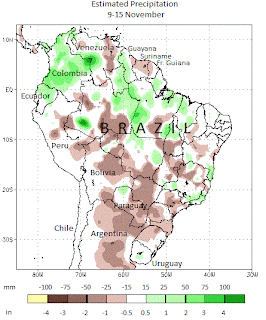Dry weather has become the rule across much of Latin America, not just this week, but for the last several weeks. This is good for places like Haiti, Costa Rica and Panama which are cleaning up after disease outbreak, flooding and landslides respectively. The dry weather is poor news in much of Central America where crops are getting close to harvest, and in Argentina where crops should be first getting planted.
Very little going on across Central America and the Caribbean this week as dry weather remains in place across the region. Some light showers did make their way across Panama and Costa Rica, both of which are still cleaning up from landslides and flooding that occurred a couple of weeks ago. Dry weather is starting to wilt crops further north across the rest of Central America. The coming week does promise to bring more precipitation to the Caribbean side of Central America, the heaviest rains will be along the coast. This is a typical winter precipitation pattern.
Haiti has remained dry since Tomas helped facilitate the spread of cholera across the country. The dry weather has allowed aid workers to move around as needed, and with daily highs just over 20oC (around 70oF) much of the standing water has likely evaporated. However, the outbreak remains widespread and environmental factors will not be enough to stop the spread of the disease.
Moisture remains limited across much of South America. Only Colombia, Ecuador and parts of Venezuela and Peru remain with significant moisture surpluses. In Colombia, there has been some localized flooding as a result of the abundant rainfall the country has been receiving. Northern Brazil has also done well, but much of the southern part of the country was dry last week. That dryness extends southward into Bolivia, Paraguay, and Argentina. Although Uruguay had sufficient rain last week, longer-term precipitation deficits remain.
The worst dryness on the continent extends from north of Buenos Aires to southeastern Paraguay, but not including Asuncion, and includes nearby parts of Rio Grande do Sul, Brazil. In the Argentine states of Corrientes and Misiones deficits peak at more than 210 mm, or 7 inches. Precipitation deficits have also grown across the less inhabited southern parts of southern Chile.




No comments:
Post a Comment